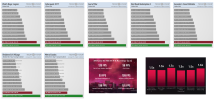Have you seen the frequencies of the 7900XT?
Basis: 1,500MHz (vs. 1,900MHz)
Game: 2,000MHz (vs. 2,300MHz)
Boost: 2,300MHz (vs. 2,400MHz)
Its a huge downgrade from the 7900XTX. And using the game frequency compute performance would have been only 8% higher than the 4080 12gb (2620Mhz boost/game frequency).
Basis: 1,500MHz (vs. 1,900MHz)
Game: 2,000MHz (vs. 2,300MHz)
Boost: 2,300MHz (vs. 2,400MHz)
Its a huge downgrade from the 7900XTX. And using the game frequency compute performance would have been only 8% higher than the 4080 12gb (2620Mhz boost/game frequency).


